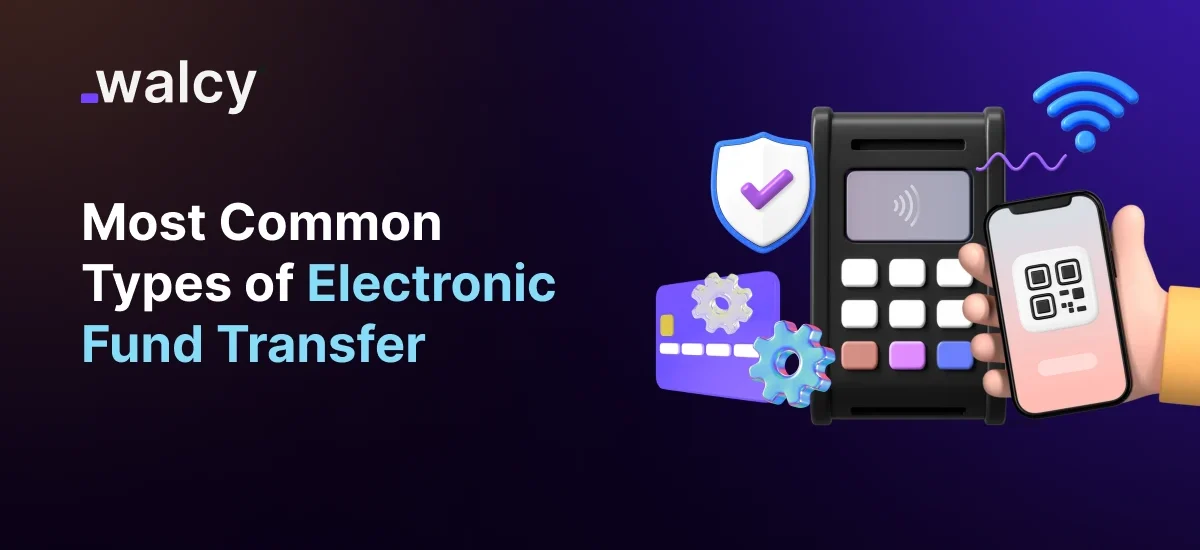EFT has become an integral part of modern financial management. From bill payments to sending money to family and friends, EFT provides a fast, safe, and efficient means of moving money electronically without physical cash or checks.
Let’s look at some of the most common types of electronic fund transfers that dominate financial landscapes.
Most Common Types of Electronic Fund Transfer
Direct Deposit
One of the common kinds of electronic funds transfers is direct deposit, whereby an employer, government agency, or other body will be in a position to place money directly into a particular bank account that belongs to the individual.
This mode, being devoid of paper checks, has ensured faster and more certain payments without any outstanding concealing. It minimizes loss or delay due to some checks, having been automated, and reduces the need for physical banking by requiring minimal time and resource usage.
Most common for payroll, tax refunds, and government benefits, direct deposit is a secure, easy alternative that works out the immediate availability of funds on payday. It is applied in an electronic fund transfer system to pay salaries, pensions, and other regularly recurring payments, making it indispensable for personal and business financial management.
Automated Teller Machine (ATM) Transfers
ATMs represent the major components of electronic bank transfer systems, which enable users to make various types of financial operations: drawing, depositing, or transferring money between accounts. These operations appear in real time, which is convenient for users who need access to funds right away.
Also, ATMs can enable a person to operate several accounts with one card, thus making the process of banking easier without requiring one to visit a branch.
Operating 24/7, ATMs offer constant availability, as one may want it. In addition to cash withdrawals and transfers, many ATMs are also able to offer bill pay services, further integrating them with the larger electronic fund transfer system.
This functionality makes ATMs an essential tool for both personal and business banking, thus enhancing financial flexibility and convenience.
Electronic Checks (eChecks)
An eCheck works similarly to any ordinary paper check; the payment is taken care of electronically instead of the actual physical transaction. Upon authorization, the amount of the eCheck is directly debited from the account of the payee and is credited into the recipient’s bank account through some sort of electronic money transfer.
In this way, it avoids the trouble of dealing with physical checks and paves the way for an accelerated and more efficient way of performing the payment.
eChecks are particularly useful in online payments, recurring bill payments, and e-commerce transactions where speed and security become imminent. Since they are processed online, eChecks have the added advantage of traceability, enabling the payee to locate and verify whether any particular receipt of money has been made or not.
They are reliable and convenient; hence, preferred means for businesses and consumers who require speed, security, and easily managed fund transfer types.
Wire Transfers
Wire transfers are a secure but highly dependable manner of transfer of big amounts both domestically and internationally. Unlike other electronic means of fund transfer, wire transfers affect direct communication between financial institutions in handling and managing the funds transfer safely in the least time possible, typically on the same day. These transactions usually bear a fee and, hence are costlier compared to other ways.
It is especially ideal for large amounts of money and international transfers. Since they are pretty fast and very secure, they’ve been widely used for businesses and people who need to perform quick and efficient transfers. Whatever the fees may be, wire transfer has been an important part of the electronic bank transfer system whenever international or high-stakes deals are at play and where other ways of transferring money might not be as fast or reliable.
Read about: Cheapest Way To Transfer Money Abroad | Ultimate Guide-2024
Online Banking Transfers
The most facilitated and widely used type of electronic fund transfer has to be online banking transfers. In this digital banking era, almost all financial institutions have online platforms or even mobile applications through which customers can easily execute internal money transfers, send money to others, or pay bills while sitting in the comfort of their homes. Transfers are thus instant or within the shortest period, and banking is easy and smooth for customers.
Available 24/7, these online banking transfers are mostly free or of low cost, thus offering flexibility without the necessity of physically visiting the bank. Maintaining personal finances, sending money to family, and paying monthly anything via online banking transfers have been a major part of electronic bank transfers by which users easily stay in control of their financial activities anytime.
Mobile Payment Systems
The need for mobile payment solutions has risen dramatically along with the surge in smartphone usage.
This includes systems such as PayPal, Venmo, Google Pay, and Apple Pay. Users can send electronic money transfers in real-time via mobile applications through the mentioned systems. They have proved pretty hassle-free in sending money to friends, buying online, and paying bills. The ease of linking to a bank account, debit card, or stored balance makes them very attractive and, as such makes the transfer of money that much easier.
With the employment of mobile payment systems in peer-to-peer payments, online shopping, and bill paying, they enable immediate transfers that are integrated smoothly with online stores and service providers. Because such systems offer speed, ease of use, and convenience, they have become one of the fastest-growing components of the electronic fund transfer system in recent times, especially when daily transactions require quick and hassle-free solutions.
ACH Transfers (Automated Clearing House)
ACH transfers represent one of the most popular forms of electronic money transmission, which helps facilitate the flow of funds between banks and other financial institutions. Unlike wire transfers, which are made individually, ACH transfers are processed in batches, making them generally slower but very cost-effective. With this in mind, ACH transfers will suit routine transactions such as payment of utility bills, mortgages, payroll, and subscription services.
ACH Transfers are commonly used for bill payments on a recurring schedule and business-to-business transactions. ACH transfers are very secure, low-cost ways to reliably handle scheduled payments. ACH Transfers lie at the heart of the electronic fund transfer system, enabling businesses and consumers to automate and manage their finances at scale and to make regular payments with much less work.
Point of Sale (POS) Transfers
Point of Sale Transfers are transactions made by customers through debit or credit cards against the retailer, eatery, or any service provider. It is an electronic money transfer process in which the money becomes available in the merchant’s account instantly. In return, the amount is transferred from the account of the customer to the merchant’s account. This seamless process is at the heart of modern retail-be it in physical locations or online stores.
Besides the POS transfer, immediate payment and secure transactions are guaranteed for the convenience and comfort of the customers, as well as efficacy towards the businesses. It will help to avoid cash handling and make shopping very convenient. It speeds up the transactions and makes them efficient. The POS transfer is very relevant in an electronic fund transfer system and can never be devoid of facilitating smooth, effective, and reliable payments across a range of industries.
Conclusion
From Direct Deposit to a Point of Sale transfer, these are just a few examples of electronic fund transfer systems. It ranged in diversity from Direct Deposit to POS transfers, showing the scope of modern financial technology in our everyday lives. Each method, whether it is the convenience of online banking transfers, the security of wire transfers, or the flexibility of mobile payment systems, has an important part in the electronic transfer of funds.
Put together, all those methods can range from routine bill payments and payroll disbursements to high-value transactions and even peer-to-peer transfers. As we go deeper into the digital world, it’s on such fund transfers that individuals and companies can make their financial decisions.
Users can optimize financial management such that transactions are carried out with maximum efficiency, based on the choice between systems and their relative merits in terms of speed, security, and cost efficiency. These, coupled with technologies, not only smoothen the financial processes but also contribute to a connected, accessible financial ecosystem-a reflection of the evolving ways of dealing with money in today’s world.
FAQs
What is direct deposit?
Direct deposit is an electronic means of depositing money from employers, government agencies, or other organizations straight into the account holder’s account without the need for physical checks.
What is an ATM transfer?
An ATM transfer is one wherein any person can withdraw cash, deposit a large amount of money, or even transfer money into accounts through an ATM. These transactions are in real-time and can also be conducted at midnight.
What are eChecks, and how do they work?
eChecks are electronic representations of paper checks. They function in a manner that they have to pass through electronic systems with the view of ensuring money is taken out from the payer’s account and credited to the recipient’s account. They can be used mostly for online payment transactions and fixed bills.
In what ways do wire transfers vary from ACH transfers?
Wire transfers typically represent high-dollar or cross-border transactions. Because wire transfers are individual transactions processed for speed, they are significantly slower compared to ACH transfers, which are processed in batches and represent the slower but cheaper alternative and are often used for recurring payments.
What are mobile payment systems?
The providers of these electronic money transfer services through mobile applications are mobile payment systems, such as PayPal and Google Pay. It is pretty attractive due to the convenience and speed it provides, integrating online shopping and bill payments therein.
Do follow us on Facebook and LinkedIn, to stay connected with us.



